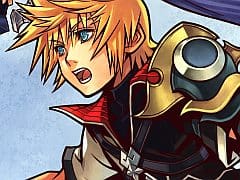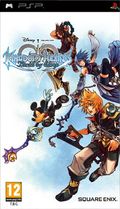You can trust VideoGamer. Our team of gaming experts spend hours testing and reviewing the latest games, to ensure you're reading the most comprehensive guide possible. Rest assured, all imagery and advice is unique and original. Check out how we test and review games here
Since around the early half of 2000 Kingdom Hearts has taken Disney in the one hand and taken Final Fantasy in the other, and then furiously rubbed its palms together until the two could fuse into a lump of franchise characters. The novelty universe had managed to become one of the best examples of a thoughtful, twee environment in mainstream RPG games but eight years of it and even the loveliest twee-land feels slightly haggard. Despite the fact that the series has had an uncanny ability to develop engaging and iconic settings, almost a decade on and it still hasn’t felt like it’s brought much more to the table than a pile of likeable worlds.
Now we have a new addition to the series on PSP, Birth by Sleep. BbS’ character roll-call includes Aurora from Sleeping Beauty, a fistful of dwarves, Cinderella, Snow White. You get the Olympic Coliseum from Hercules and Deep Space from Lilo & Stitch. You get Moogles and some face time by FF’s own Zack Fair.
The game takes place ten years before the original Kingdom Hearts, with characters Terra, Ventus and Aqua serving as your main protagonists. You might vaguely recognise them from back in Kingdom Hearts 2 where they had been briefly featured but now you get a slightly more thorough idea of their characters.
The three are a trio of close friends and apprentice Keyblade-wielders who are essentially in the process of fighting darkness. The game takes you across multiple worlds and storylines featuring the usual Disney fair, but even with the plot being as extensive as it is, you have to ignore it for the most part. At its best the game squeezes out a set of completely standard storytelling traditions. The gist of the plotline revolves around the standard JRPG imbalance of light versus darkness. Darkness is bad, negative emotions are bad, and monsters called the Unversed feed on that negativity. Cut to monsters popping up around a moping, depressive Cinderella sitting in a ripped gown and you get an idea of how Disney lore gets fed into this as a plot device.
At worst it’s just a bit baffling. Take the introduction where you first meet Ven, a grown teenager wrapped in bed linen next to the sea like a giant, wet, adult baby who then plummets into the ocean wrapped in his linen body-nappy and swims through the watery depths like a kind of man-seal. But beyond the usual set of confusing plot elements the three-way narrative is surprisingly well constructed.
You get a three-part Disney-centric plotline with each narrative section playing out based on which of the trio of characters you’re commanding. Each character visits the same cluster of worlds, all relating to Disney lore. It should become repetitive by the second time you see the same magical kingdom but each character is given entirely different objectives, meet entirely different characters, and often travel in entirely new areas of the world. Occasionally their visits will even overlap, with one character running into another and giving the other a run-down of their current situation. It’s impressive in-game storytelling for a story that essentially amounts to stock thematic material from every game of the last few decades.
The primary difference between this game and any of the others in the series is a shift in the gameplay mechanics. New to the game are Dimension Links which are used to summon allies who will use their powers to help the player. Your character will D-Link with other in-game characters as you progress, temporarily providing you with a range of new attacks and finishing moves, replacing your old ones. You get the Command System which relates to a gauge that progressively fills on your screen in-battle. When the gauge is filled your battle style changes or levels up.
You get Command Board, a new feature that appears once you complete a world. The Command Board functions as a makeshift board game: a die is thrown and the player moves, with each space having a specific effect on your character. It can be used to power up attacks and level them up.
Beyond the noticeable gameplay changes Birth by Sleep supports six players in four multiplayer modes in the Mirage Arena. You can fight one another in a deathmatch, fight co-operatively in a Survival mode consisting of waves of Unversed, race competitively in Rumble Racing or play the Command Board board game.
All this makes the button mashing element feel slightly meatier and more involving but it’s too early to say how the story is going to play out. JRPGs are always slow burners, so we’ll have to wait and see if the plot comes together by its conclusion.
Kingdom Hearts: Birth by Sleep is due for release on PSP in September.

/https://oimg.videogamer.com/images/a7a4/kingdom_hearts_birth_by_sleep_29.jpg)






